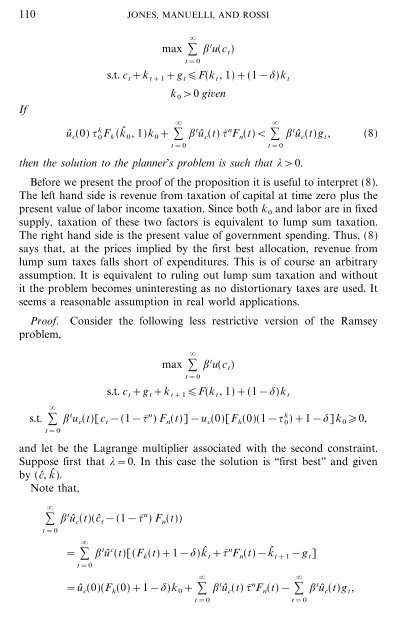On the Optimal Taxation of Capital Income
On the Optimal Taxation of Capital Income
On the Optimal Taxation of Capital Income
You also want an ePaper? Increase the reach of your titles
YUMPU automatically turns print PDFs into web optimized ePapers that Google loves.
110 JONES, MANUELLI, AND ROSSI<br />
If<br />
s.t. c t+k t+1+g t<br />
u^ c(0) { k<br />
0 F k(k 0,1)k 0+:<br />
max : ; t u(ct) t=0<br />
k 0>0 given<br />
t=0<br />
F(k t,1)+(1&$)k t<br />
; t u^ c( t ) { n F n( t )< :<br />
t=0<br />
; t u^ c(t)g t, (8)<br />
<strong>the</strong>n <strong>the</strong> solution to <strong>the</strong> planner's problem is such that *>0.<br />
Before we present <strong>the</strong> pro<strong>of</strong> <strong>of</strong> <strong>the</strong> proposition it is useful to interpret (8).<br />
The left hand side is revenue from taxation <strong>of</strong> capital at time zero plus <strong>the</strong><br />
present value <strong>of</strong> labor income taxation. Since both k0 and labor are in fixed<br />
supply, taxation <strong>of</strong> <strong>the</strong>se two factors is equivalent to lump sum taxation.<br />
The right hand side is <strong>the</strong> present value <strong>of</strong> government spending. Thus, (8)<br />
says that, at <strong>the</strong> prices implied by <strong>the</strong> first best allocation, revenue from<br />
lump sum taxes falls short <strong>of</strong> expenditures. This is <strong>of</strong> course an arbitrary<br />
assumption. It is equivalent to ruling out lump sum taxation and without<br />
it <strong>the</strong> problem becomes uninteresting as no distortionary taxes are used. It<br />
seems a reasonable assumption in real world applications.<br />
Pro<strong>of</strong>. Consider <strong>the</strong> following less restrictive version <strong>of</strong> <strong>the</strong> Ramsey<br />
problem,<br />
s.t. :<br />
t=0<br />
max :<br />
s.t. c t+g t+k t+1<br />
t=0<br />
; t u(c t)<br />
F(k t,1)+(1&$)k t<br />
; t u c(t)[c t&(1&{ n ) F n( t )]&u c(0)[F k(0)(1&{ k<br />
0)+1&$]k 0<br />
and let be <strong>the</strong> Lagrange multiplier associated with <strong>the</strong> second constraint.<br />
Suppose first that *=0. In this case <strong>the</strong> solution is ``first best'' and given<br />
by (c^, k ).<br />
Note that,<br />
:<br />
t=0<br />
; t u^ c( t )(c^ t&(1&{ n ) F n( t ))<br />
= :<br />
t=0<br />
; t u^ c ( t )[(F k(t)+1&$)k t+{ n F n( t )&k t+1&g t]<br />
=u^ c(0)(F k(0)+1&$)k 0+ :<br />
t=0<br />
; t u^ c( t ) { n F n( t )& :<br />
t=0<br />
; t u^ c( t ) g t ,<br />
0,
















